
Tiền nhiệm Millard Fillmore
Kế nhiệm James Buchanan
Đảng Đảng Dân chủ
Sinh 23 tháng 11, 1804
Mất 8 tháng 10, 1869 (64 tuổi)
Phu nhân Jane Appleton Pierce
Franklin Pierce (1804-1869) là một chính khách và là Tổng thống Hoa Kỳ thứ 14 từ năm 1853 đến 1857. Ông là vị tổng thống duy nhất đến từNew Hampshire và là tổng thống thứ hai sinh vào thế kỉ 19. Ông là vị Tổng thống nổi tiếng bởi biệt tài ghi nhớ rất tốt, ông đã đọc thuộc lòng thành thạo bài diễn văn nhậm chức dài 3.000 từ của mình một cách rành rọt. Trong cuộc sống, ông là người nghiện rượu nặng và khá trầm cảm.
Tham khảo thêm:
For other uses, see Franklin Pierce (disambiguation).
 |
| 14th President of the United States |
In office
March 4, 1853 – March 4, 1857
Vice President William R. King (1853)
None (1853-1857)
Preceded by Millard Fillmore
Succeeded by James Buchanan
from New Hampshire
In office
March 4, 1837 – February 28, 1842
Preceded by John Page
Succeeded by Leonard Wilcox
Member of the U.S. House of Representatives
from New Hampshire's At-large district
In office
March 4, 1833 – March 4, 1837
Preceded by Joseph Hammons
Succeeded by Jared Williams
Personal details
Born November 23, 1804
Died October 8, 1869 (aged 64)
Resting place Old North Cemetery
Political party Democratic
Spouse(s) Jane Appleton
Children Franklin
Frank Robert
Profession Lawyer
Religion Episcopal
Military service
Service/branch U.S. Army
Years of service 1846 - 1848
Rank Brigadier General
Battles/wars Mexican-American War
Franklin Pierce (November 23, 1804 – October 8, 1869) was the 14th President of the United States (1853–1857) and is the only President fromNew Hampshire. Pierce was a Democrat and a "doughface" (a Northerner with Southern sympathies)[1] who served in the U.S. House of Representativesand the Senate. Pierce took part in the Mexican-American War and became a brigadier general in the Army. His private law practice in his home state, New Hampshire, was so successful that he was offered several important positions, which he turned down. Later, he was nominated as the party's candidate for president on the 49th ballot at the 1852 Democratic National Convention.[2] In the presidential election, Pierce and his running mate William R. King won by a landslide in the Electoral College. They defeated the Whig Party ticket of Winfield Scott and William A. Graham by a 50 percent to 44 percent margin in the popular vote and 254 to 42 in the electoral vote.
He made many friends, but he suffered tragedy in his personal life; all of his children died when young. As president, he made many divisive decisions which were widely criticized and earned him a reputation as one of the worst presidents in U.S. history. Pierce's popularity in the Northern statesdeclined sharply after he supported the Kansas–Nebraska Act, which replaced the Missouri Compromise and renewed debate over the expansion ofslavery in the American West. Pierce's credibility was further damaged when several of his diplomats issued the Ostend Manifesto. The historian David Potter concludes that the Ostend Manifesto and the Kansas-Nebraska Act were "the two great calamities of the Franklin Pierce administration.... Both brought down an avalanche of public criticism."[3] More importantly, says Potter, they permanently discredited Manifest Destinyand "popular sovereignty" as political doctrines.
Abandoned by his party, Pierce was not renominated to run in the 1856 presidential election; he was replaced by James Buchanan as the Democratic candidate. After losing the Democratic nomination, Pierce continued his lifelong struggle with alcoholism and his marriage to Jane Means Appleton Pierce fell apart. His reputation was destroyed during the Civil War when he declared support for the Confederacy, and personal correspondence between Pierce and the Confederate President Jefferson Davis was leaked to the press. Pierce died in 1869 from cirrhosis of the liver.
Philip B. Kunhardt and Peter W. Kunhardt reflected the views of many historians when they wrote in The American President that Pierce was
"a good man who didn't understand his own shortcomings. He was genuinely religious, he loved his wife, and he reshaped himself so that he could adapt to her ways and show her true affection. He was one of the most popular men in New Hampshire, polite and thoughtful, easy, and good at the political game, charming and fine and handsome. However, he has been criticized as timid and unable to cope with a changing America."
Early life and education
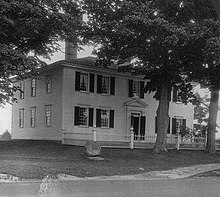 |
| Franklin Pierce Homestead (1804), Hillsborough |
Franklin Pierce was born on November 23, 1804, likely at theFranklin Pierce Homestead, which his father had built that year in Hillsborough, New Hampshire. Another possible birthplace was the family's former log cabin, which site is now underFranklin Pierce Lake. He was the fifth of eight children. Their father wasBenjamin Pierce, a frontier farmer who had been aRevolutionary War soldier, and a state militia general. He was elected as a two-time Democratic-Republican governor of New Hampshire when Franklin was a young man. Benjamin Pierce was a direct descendant of Thomas Pierce (1618–1683),[4][5] who was born inNorwich, Norfolk, England and immigrated to the Massachusetts Bay Colony. Franklin Pierce's mother was Anna B. Kendrick. Former First Lady of the United States Barbara Pierce Bush is a distant cousin.
Pierce lived at the Homestead from infancy to his marriage in 1834, with the exception of seven years spent at school, college and the study of law. Pierce family descendants owned the house until 1925.[6]
Education
Pierce attended school at Hillsborough Center and moved to the Hancock Academy in Hancock at the age of 11; he transferred to FrancestownAcademy in the spring of 1820. Friends recalled that just after he entered the school, he became homesick and returned home barefoot. Soon the boy walked the seven miles back to school. Later that year he transferred to Phillips Exeter Academy to prepare for college. In fall 1820, Pierce entered Bowdoin College in Brunswick, Maine, where he joined literary, political, and debating clubs.[5]
At Bowdoin he met the writers Nathaniel Hawthorne, with whom he formed a lasting friendship,[7][8] and Henry Wadsworth Longfellow.[9] He also met Calvin E. Stowe, Seargent S. Prentiss, and his future political rival, John P. Hale, when he joined the Athenian Society, a group of students with progressive political leanings.
In his second year of college, Pierce had the second lowest grades in his class, but he worked to improve them; he ranked third among his classmates when he graduated in 1824. In 1826 he entered Northampton Law School in Northampton, Massachusetts, and he later studied under Governor Levi Woodbury and Judge Edmund Parker in their practice in Amherst, New Hampshire.[10]
Early political career
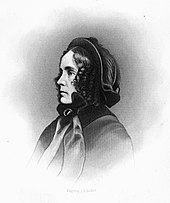 |
| Jane Appleton Pierce |
After graduating from college and completing his law degree, Pierce entered politics. He rose to a central position in the Democratic party of New Hampshire and became a member of the Concord Regency leadership group.
After establishing his law practice, in 1828 he was elected to the lower house of the New Hampshire General Court, the New Hampshire House of Representatives, the same year that his father was elected as governor. He served in the State House from 1829 to 1833, and was elected Speakerfrom 1832 to 1833.[10]
In 1832, Pierce was elected as a Democrat to the 23rd and 24th Congresses (March 4, 1833 – March 4, 1837). He was 27 years old, the youngest U.S. Representative at the time.
In 1836, he was elected by the New Hampshire General Court as a Democrat to the United States Senate, serving from March 4, 1837, to February 28, 1842, when he resigned. He was chair of the U.S. Senate Committee on Pensions during the 26th Congress.
After his service in the Senate, Pierce resumed the practice of law inConcord with his partner Asa Fowler. He was appointed as the United States Attorney for the District of New Hampshire from 1845 to 1847. He refused the Democratic nomination for Governor of New Hampshire and declined the appointment asAttorney General of the United States tendered by President James K. Polk.
[edit]Marriage and family
 | |
| November 19, 1834, Pierce married Jane Means Appleton(1806–63), the daughter of Jesse Appleton, a former president of Bowdoin College. Jane was Pierce's opposite. Born into an elite Whig family, she was shy, whereas he was very extroverted. Often ill, she was deeply religious and pro-temperance.[11] They lived permanently in Concord. They had three children, all of whom died in childhood: |
Franklin Pierce, Jr. (February 2, 1836 – February 5, 1836)
Frank Robert Pierce (August 27, 1839 – November 14, 1843), died at the age of four from epidemic typhus
Benjamin Pierce (April 13, 1841 – January 6, 1853), died at the age of 11 in an accident.
None of the sons lived to see his father become President.[12]
Mexican-American War
 |
| Portrait of Franklin Pierce as ageneral mounted on a horse. |
Pierce volunteered to serve in the Army during the Mexican-American War. He was commissioned as a colonel in the Infantry on February 16, 1847. On March 3, 1847 he was promoted to brigadier general and took command of a brigade of reinforcements for Winfield Scott's army marching onMexico City. His brigade was designated the 1st Brigade in the newly created 3rd Division and joined Scott's army in time for the Battle of Contreras. During the battle he was seriously wounded in the leg when he fell from his horse.[13]
He returned to his command the following day, but during the Battle of Churubusco the pain in his leg became so great that he passed out and had to be carried from the field. His political opponents used this against him, claiming that he left the field because of cowardice instead of injury. In his memoirs,Ulysses S. Grant (not a supporter of Pierce politically), who observed Pierce firsthand during the war, described criticism of Pierce's service as "unfair and unjust," and Pierce as "a gentleman and a man of courage."[14] Pierce returned to command and led his brigade throughout the rest of the campaign, resulting in the capture of Mexico City. He resigned from the Army on March 28, 1848.
Although he was a political appointee, he proved that he had some skill as a military commander. He returned home and served as president of the New Hampshire state constitutional convention in 1850.[15][16]
Election of 1852
The Gamecock & the Goose A Whig Party cartoon favoring Pierce's main opponent, Winfield Scott.
At the Democratic National Convention of 1852, Pierce was not considered a serious candidate for the presidential nomination. He had no credentials as a major political figure or leader, and had not held elective office for the last ten years. The convention assembled on June 1 in Baltimore, Maryland, with four major contenders—Stephen A. Douglas, William L. Marcy, James Buchanan and Lewis Cass—for the nomination. Most of those who had left the party with Martin Van Buren to form the Free Soil Party had returned. To unite the various Democratic Party factions before voting on a nominee, delegates adopted a party platform that rejected further "agitation" over the slavery issue and supported the Compromise of 1850.[4]
When the balloting for president began, the four candidates deadlocked, with no candidate reaching even a simple majority, much less the requiredsupermajority of two-thirds. On the thirty-fifth ballot, Pierce was put forth to break the deadlock as a compromise candidate. Pierce's long career as a party activist and consistent supporter of Democratic positions made him popular among delegates. He had never fully explained his views on slavery, allowing all factions to view him as reasonably acceptable. His service in the Mexican-American War would allow the party to portray him as a war hero. On June 5, delegates unanimously nominated Pierce on the 49th ballot. Alabama Senator William R. King was chosen as the nominee for Vice President.[17]
The United States Whig Party's candidate was General Winfield Scott of Virginia, under whom Pierce had served in the Mexican-American War; his running mate was Secretary of the Navy William A. Graham. Scott – nicknamed "Old Fuss and Feathers" – ran a blundering campaign.
The Whigs' platform was almost indistinguishable from that of the Democrats, reducing the campaign to a contest between the personalities of the two candidates and helping to drive voter turnout in the election to its lowest level since 1836. Pierce's affable personality and lack of strongly held positions helped him prevail over Scott, whose antislavery views hurt him in the South. Pierce's military service effectively neutralized Scott's reputation as a celebrated war hero. Irish Catholic support of the Democratic Party and disdain for the Whig Party also helped Pierce.
Electoral map of the 1852 presidential election.
The Democrats' slogan was "We Polked you in 1844; we shall Pierce you in 1852!" (a reference to the victory of James K. Polk in the 1844 election).[18]This proved to be true, as Scott won only the states of Kentucky, Tennessee, Massachusetts, and Vermont. The total popular vote was 1,601,274 to 1,386,580, or 50.9% to 44.1%. Pierce won 27 of the 31 states, including Scott's home state of Virginia. John P. Hale, who like Pierce was from New Hampshire, was the nominee of the remnants of the Free Soil Party, garnering 155,825 votes (5% of the total).
The 1852 election was the last presidential contest in which the Whigs fielded a candidate. The Kansas-Nebraska Act, passed in 1854, divided the Whigs. The Whig Party splintered and most of its adherents migrated to the nativist American Party Know Nothings, the Constitutional Union Party, and the newly formed Republican Party.
At his inauguration, Pierce, at age 48, was the youngest President to have taken office, a record he would keep until Ulysses S. Grant took office in 1869 at 46 years old.
On January 6, 1853, weeks after his election as president, the Pierces and their last son Benjamin were in a train accident. The boy was nearly decapitated. Pierce covered him with a sheet, hoping to spare his wife, but Jane also saw their son. They both suffered severe depression afterward, which affected Pierce's performance throughout his presidency. After Benjamin's death, Jane was overcome with melancholia and became distant from her husband during his presidency. She was known as "the shadow of the White House."[citation needed]
Presidency 1853–1857
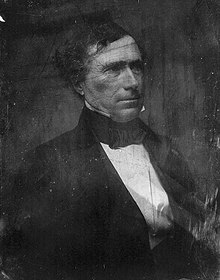 |
| Franklin Pierce, c.1851-1860 |
Pierce's Vice President William R. Kingdied a little more than one month after his inauguration; for the remainder of his term, Pierce had no Vice President.
Pierce served as President from March 4, 1853, to March 4, 1857. He began his presidency in mourning. Two months before, on January 6, 1853, the President-elect's family had been trapped in a train from Boston when their car derailed and rolled down an embankment near Andover, Massachusetts. Pierce and his wife survived but saw their last son, 11-year-old Benjamin, crushed to death.[19][not in citation given] Jane Pierce viewed the train accident as a divine punishment for her husband's pursuit and acceptance of high office.
The first president to have been born in the 19th century, Pierce chose to "affirm" his oath of office rather than swear it, becoming the first president to do so; he placed his hand on a law book rather than on a Bible. He was the first president to recite his inaugural address from memory. Pierce hailed an era of peace and prosperity at home and urged a vigorous assertion of US interests in its foreign relations. "The policy of my Administration," said the new president,"will not be deterred by any timid forebodings of evil from expansion. Indeed, it is not to be disguised that our attitude as a nation and our position on the globe render the acquisition of certain possessions not within our jurisdiction eminently important for our protection".[20]
The nation was enjoying economic growth and relative tranquillity, and the Compromise of 1850 calmed the debate over slavery. When the issue flamed up early in his administration, Pierce did little to cool the passions it aroused. Sectional conflicts reignited.[21]
[edit]Administration
Pierce selected men of differing opinions for his Cabinet, including colleagues he knew personally and Democratic politicians. Many anticipated the diverse group would soon break up, but it remained unchanged during Pierce's four-year term (as of 2012, the only presidential cabinet to do so). In foreign policy, Pierce sought to display a traditional Democratic assertiveness. Various interests nursed ambitions to detach nearby Cuba from a weak and distant Spain, open trade with a reclusive Japan, and gain the advantage over Britain in Central America. Although the Perry Expedition to Japan was a success, Pierce's leadership increasingly came into question when poorly anticipated developments exposed failures of Administration planning and consultation.[22]
Pierce's administration aroused sectional apprehensions when it pressured the United Kingdom to relinquish its interests along part of the Central American coast. Three US diplomats in Europe drafted a proposal to the president to purchase Cuba from Spain for $120 million (USD), and justify the "wresting" of it from Spain if the offer were refused. The publication of the Ostend Manifesto, which had been drawn up on the insistence of Pierce's Secretary of State, provoked the scorn of Northerners who viewed it as an attempt to annex a slave-holding possession to bolster Southern interests. It helped discredit the expansionist policies the Democratic Party had supported in the 1844 election. The Gadsden Purchase from Mexico similarly exposed the seething unresolved sectional conflicts inherent in national expansion.
 |
Forcing Slavery Down the Throat of a Freesoiler
|
An 1856 cartoon depicts a giant free soilerbeing held down byJames Buchanan andLewis Cass standing on theDemocraticplatform marked "Kansas," "Cuba" and "Central America." President Pierce also holds down the giant's beard as Stephen A. Douglas shoves a black man down his throat.
The greatest challenge to the country's equilibrium during the Pierce administration, though, was the passage of the Kansas-Nebraska Act in 1854. It repealed the Missouri Compromiseand reopened the question of slavery in the West. This measure, sponsored by Senator Stephen A. Douglas, originated in a drive to promote a transcontinental railroad with a link from Chicago, Illinois, to California through Nebraska.
Secretary of War Jefferson Davis, advocate of a southern transcontinental route, had persuaded Pierce to send James Gadsden to Mexico to buy land for a southern railroad. He purchased the area now comprising southern Arizona and part of southern New Mexico for $10 million (USD), commonly known as the Gadsden Purchase.[15] This became known as the greatest success of the Pierce presidency. Under Pierce's watch, CommodoreMatthew C. Perry concluded a treaty with Japan allowing American trade with that country.[23]
Pierce fulfilled the expectations of Southerners who had supported him by vigilantly enforcing the Fugitive Slave Act when Anthony Burns was seized in Boston in 1854. Federal troops enforced the return to his owner against angry crowds.[24]
Organizing the territories of Kansas and Nebraska sparked more tensions related to whether to permit slavery there. To win Southern support for organizing Nebraska, Douglas added a provision declaring the Missouri Compromise to be invalid. The bill provided that the residents of the new territories could vote to determine whether they could allow slavery. Although Pierce's cabinet had made other proposals on this issue, Douglas and several southern Senators successfully persuaded Pierce to support Douglas' plan.
As the act was being debated, settlers on both sides of the slavery issue rushed into the state to be present for the voting. The passage of the Kansas-Nebraska Act resulted in so much violence between groups that the territory became known as Bleeding Kansas. Pro-slavery Border Ruffians, mostly from Missouri, illegally voted in the elections to set up the government, but Pierce recognized it anyway. When Free-Staters set up a shadow government, called the Topeka Constitution, Pierce termed their work an act of "rebellion." The president continued to recognize the pro-slavery legislature, which was dominated by Democrats, even after a Congressional investigative committee found its election to have been illegitimate. He dispatched federal troops to break up a meeting of the shadow government in Topeka.
The Kansas-Nebraska Act and its results in having Kansas admitted as a slave state provoked outrage among northerners, who already viewed Pierce as kowtowing to slave-holding interests. This contributed to the Republican Party, as well as to critical assessments of Pierce as untrustworthy and easily manipulated. Having lost public confidence, Pierce was not nominated by his party for a second term. As a result of threats and the passions inspired by Kansas, Pierce hired a full-time bodyguard - the first president to do.
Historians have ranked Pierce as among the least effective Presidents.[citation needed] He was unable to steer a steady, prudent course that might have sustained a broad measure of support. Having publicly committed himself to an ill-considered position, he maintained it steadfastly, at disastrous cost to his reputation.
 |
Franklin Pierce,1858, byGeorge Healy
|
Cabinet
The Pierce Cabinet
OfficeNameTerm
PresidentFranklin Pierce 1853–1857
None 1853–1857
Secretary of StateWilliam L. Marcy 1853–1857
Secretary of TreasuryJames Guthrie 1853–1857
Secretary of WarJefferson Davis 1853–1857
Attorney GeneralCaleb Cushing 1853–1857
Postmaster GeneralJames Campbell 1853–1857
Secretary of the NavyJames C. Dobbin 1853–1857
Supreme Court appointments
Pierce appointed the following Justices to the Supreme Court of the United States:
States admitted to the Union
No states were admitted.
Later life
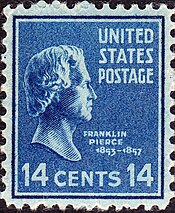 |
| Franklin Pierce, Issue of 1938 |
After losing the Democratic nomination for reelection in 1856, Pierce retired and traveled with his wife overseas. He returned to the U.S. in 1859 in time to comment on the growing sectional crisis between the South and the North, often criticizing Northern abolitionists for encouraging ugly feelings between the two sections. In 1860 many Democrats viewed Pierce as a solid compromise choice for the presidential nomination, uniting both Northern and Southern wings of the party, but Pierce declined to run.
During the Civil War, Pierce attacked Lincoln for his order suspending habeas corpus. Pierce argued that even in a time of war, the country should not abandon its protection of civil liberties.
Pierce's stand won him admirers with the emerging Northern Peace Democrats, but enraged certain members of the Lincoln administration: in 1862 Secretary of State William Seward sent Pierce a letter accusing him of being a member of the seditious Knights of the Golden Circle. Outraged, Pierce responded and demanded that Seward put his response in the official files of the State Department. When that didn't happen, a Pierce supporter in the US Senate, Milton Latham of California, had the entire Seward-Pierce correspondence read into the Congressional Globe. Nearly every Seward biographer has since considered the Pierce-Seward exchange as a blot on the Secretary's otherwise notable career.
 |
| Presidential Dollar of Franklin Pierce |
In 1864, friends again put his name in play for the Democratic nomination, but by a letter read out loud to the delegates, Pierce said he would not run.
The year before, Pierce's reputation was greatly damaged in the North during the aftermath of Vicksburg. Union soldiers serving under General Hugh Ewing's command captured Confederate President Jefferson Davis' Fleetwood Plantation, and Ewing turned over Davis' personal correspondence to his brother-in-law William T. Sherman.[25] However, Ewing also sent copies of the letters to friends in Ohio. Those letters revealed Pierce's deep friendship with Davis and ambivalence about the goals of the war. As early as 1860, Pierce had written to Davis about "the madness of northern abolitionism." Another letter stated that he would "never justify, sustain, or in any way or to any extent uphold this cruel, heartless, aimless unnecessary war," and that "the true purpose of the war was to wipe out the states and destroy property."[26][27] Abolitionist author Harriet Beecher Stowe, who had long disliked Pierce, now referred to him as "the archtraitor."[25]
On April 16, 1865, when news had spread of the murder of President Lincoln, an angry mob of young teenagers gathered outside Pierce's home in Concord. Earlier that day a different mob had thrown black paint on the front porch of former President Millard Fillmore, who, like Pierce, was also regarded as a Lincoln detractor. The crowd in Concord wanted to know why Pierce's house was not dressed with black bunting and American flags, the visual proof of grief being used that day by millions of people across the country. Pierce came outside to confront the crowd and said he, too, was saddened by Lincoln's passing. When a voice in the crowd yelled out "Where is your flag?" Pierce became angry and recalled his family's long devotion to the country, including both his and his father's service in the military. He said he needed to display no flag to prove that he was a loyal American. The crowd soon quieted down and even cheered and applauded the former president as he went back into his home.
Franklin Pierce died in Concord, New Hampshire, at 4:49 am on October 8, 1869, at 64 years old from cirrhosis of the liver. President Ulysses S. Grant, who later defended Pierce's service in the Mexican War, declared a day of national mourning. Newspapers across the country carried lengthy front-page stories examining Pierce's colorful and controversial career. He was interred next to his wife and two of his sons, all of whom had predeceased him, in the Minot Enclosure in the Old North Cemetery of Concord.[28]
 |
Pierce's grave at the Old North Cemetery,
Concord, NH
|
In his last will, which he signed January 22, 1868, he left an unusually large number of specific bequests to friends, family and neighbors, including the children of Nathaniel Hawthorne. He left $1,000 in trust to the local library. The interest was used to purchase books. He left gifts of money, paintings, and other items to various people. The cane of General Lafayette was among the bequests. His nephew Frank Pierce received the residue.[29]
Legacy
Places named after President Pierce:
Pierce County in Washington, Nebraska, Georgia, and Wisconsin (but not the one in North Dakota, which was actually named after Gilbert Ashville Pierce)
Franklin Pierce Lake (a reservoir in New Hampshire which covers the site of a log cabin which the Pierce family lived in and where Franklin may have been born)
Pierce was portrayed by Porter Hall in the 1944 film The Great Moment[30] and voiced by Sargent Shriver in the PBS documentary series The American President.[31]
Kế Nhiệm: James Buchanan



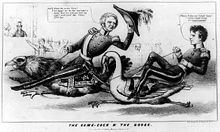
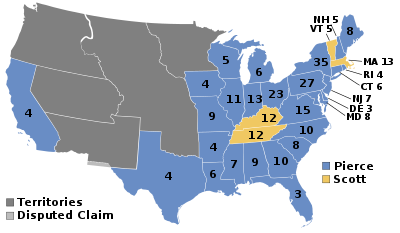

No comments:
Post a Comment